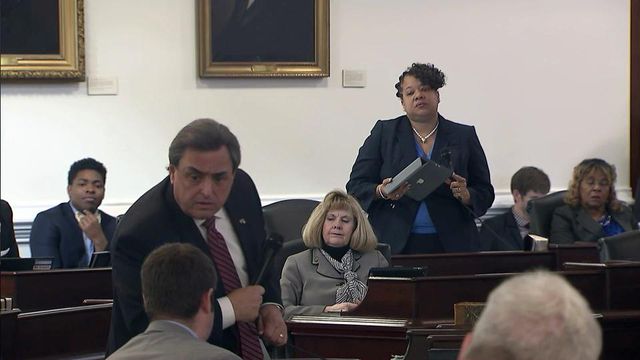Lawmakers work to redraw congressional maps, delay elections
The state House and Senate set to work Thursday redrawing the maps for North Carolina's 13 congressional districts. Unless the Supreme Court steps in, primaries for U.S. House will be delayed.
Posted — UpdatedMeanwhile, House members were getting ready to debate a bill that would set elections in those new districts for June 7.
Senators voted 32-15, mainly along party lines, to approve a new set of maps, while House members worked to create a new schedule for any congressional elections.
"This map before us is what we consider an answer to what the court asked us to do," Sen. Bob Rucho, R-Mecklenburg, told his colleagues.
But Rucho and his fellow Republicans encountered criticism of their efforts, saying they've merely replaced a racial gerrymander with one based on party affiliation.
"Friends, we live in North Carolina, not North Korea," said Sen. Josh Stein, D-Wake. "Voters should choose their representatives, not the other way around."
Following the 2010 election, Republicans took control of the General Assembly and the ability to redraw the districts from which U.S. House members are elected. Those maps became the subject of state and federal lawsuits almost as soon as they were completed. A trio of federal judges decided two weeks ago that lawmakers had unconstitutionally relied too much on race in drawing two districts and ordered lawmakers to redraw them by Friday.
Mapping the way
The major criticism the three-judge panel leveled at the 2011 congressional maps was that more than half the voters in the 1st District and the 12th District were black.
In the 1st District, which sprawls through northeastern North Carolina, the black voting-age population dropped from 52 percent to 44 percent on the newly drawn maps. The black voting population in the 12th District, which stretched from Charlotte to Greensboro, would drop from 50 percent on the old maps to 35 percent on the redrawn map.
The new map appears to be more racially integrated than the current one. Of the 10 Republican-leaning districts, eight are more diverse than they were under the 2011 maps. It also keeps 87 of North Carolina's counties together, eliminating the serpentine tentacles that characterized the districts drawn five years ago.
"At least we finally got a map that makes sense when you look at it," said Senate Majority Leader Harry Brown, R-Onslow.
While the maps are easier to understand, Democrats insisted that they still would run afoul of constitutional requirements.
"By dealing with one constitutional problem ... what you have done is create another constitutional problem with political gerrymandering," Stein said.
He pointed to statistics showing that, while half of the voters in North Carolina cast ballots for Democratic congressional candidates in 2014, only three Democrats were elected to Congress.
"This brazen gerrymander undermines our democracy," he said.
But Brown pointed out that an analysis that accompanied the newly drawn maps showed some Democrats, particularly Attorney General Roy Cooper, could win even in Republican-leaning districts.
"For you to say how gerrymandered this map is when a Democrat could win every single district, it makes no sense," Brown said.
At other points on the Senate floor, Democrats pushed Rucho and his colleagues as to whether consultants might not have initially looked at racial data before getting instructions to rely solely on political and other factors.
"Perhaps the consultant wasn't completely bound by those instructions," Sen. Floyd McKissick, D-Durham, said.
Rucho insisted that the consultant followed lawmakers' instructions to follow county lines as much as possible.
Senators also rejected an amendment by Sen. Jeff Jackson, D-Mecklenburg, that would have created a nonpartisan redistricting commission.
The new map goes to the state House for consideration on Friday.
Timing is at issue
As senators debated the new maps, the House Redistricting Committee debated timing, struggling to find a date for new congressional elections.
Voting by mail has already begun for North Carolina's March 15 primary, which was to include congressional elections, but with the maps up in the air, those races would likely have to shift to another date. Elections Director Kim Strach told the committee that a separate statewide election would cost the state $9.5 million.
Another potential difficulty had to do with North Carolina's runoff election laws. If no candidate gets 40 percent of the vote in a first primary, the front-runner can be challenged to a second primary.
State law says that only voters who voted in the first primary can vote in the second. If the state tried to hold the new congressional primary on the same day it held its primary runoffs, Strach said, two slightly different sets of voters would be eligible.
"We do not have the capability in our electronic poll books to hold a first primary and second primary on the same day," Strach told the committee.
Lawmakers have tentatively solved that problem by eliminating second primaries.
Related Topics
• Credits
Copyright 2024 by Capitol Broadcasting Company. All rights reserved. This material may not be published, broadcast, rewritten or redistributed.






